18 Ducks with Green Heads (Complete ID Guide)
If you’ve spent any time by a pond or lake, you’ve likely spotted ducks with glossy green heads that seem to shimmer and glow as the sunlight hits them. Those stunning greens aren’t paint or pigments but light bouncing off tiny structures in their feathers, creating that glossy, almost metallic look we all admire.
As a birdwatcher, I still find myself pausing every time I spot that glint of green among the reeds. It’s one of those colors that never gets old — bold, elegant, and instantly recognizable. Some ducks wear it like a crown, while others hide it in subtle shades that only appear when the sun catches them just so.
In this list, we’ll take a closer look at 18 ducks that feature green heads — from the familiar faces you might see at your local park to rare and remarkable species found across the world.
- 1. Mallard
- 2. Northern Shoveler
- 3. American Wigeon
- 4. Green-winged Teal
- 5. Common Goldeneye
- 6. Greater Scaup
- 7. Lesser Scaup
- 8. Cayuga Duck
- 9. Bufflehead
- 10. Baikal Teal
- 11. Falcated Duck
- 12. Common Shelduck
- 13. Red-breasted Merganser
- 13. Common Merganser
- 14. Wood Duck
- 15. Chestnut Teal
- 16. Spectacled Eider
- 17. Tufted Duck
- 18. Baer’s Pochard
1. Mallard
Scientific Name: Anas platyrhynchos
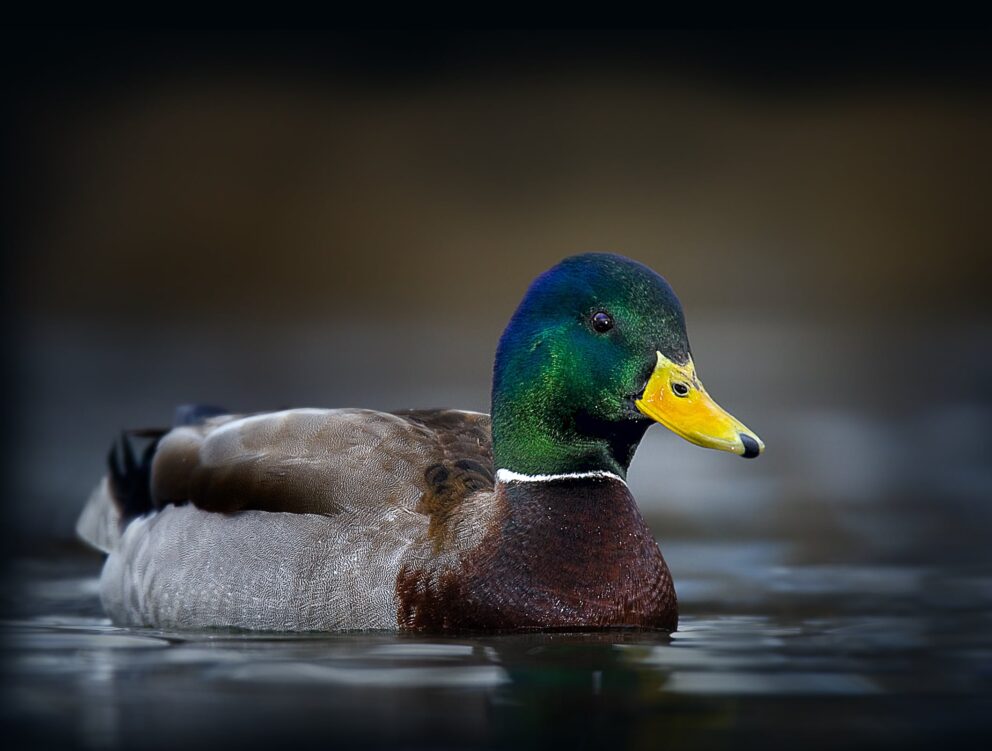
The first duck that comes to mind for nearly every duck enthusiast is undoubtedly the male mallard — instantly recognizable by its shimmering, emerald-green head that gleams in the sunlight. He also wears a white collar and has a bright yellow bill — very handsome indeed! The female, on the other hand, is dressed in soft brown feathers that help her blend into reeds and nests. Mallards are everywhere — in city parks, farm ponds, and quiet rivers — and they’re the ancestors of most domestic ducks you see today.
2. Northern Shoveler
Scientific Name: Spatula clypeata
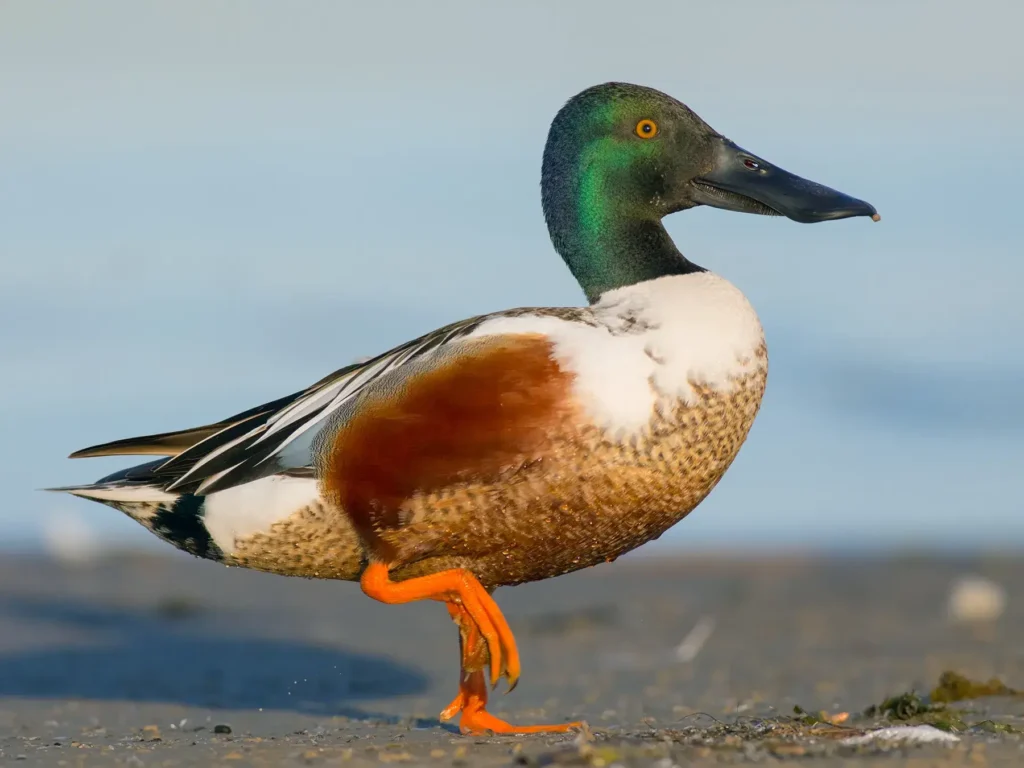
Spotted a duck with the big spoon-shaped bill? — that’s a Northern Shoveler! The male’s head shines a deep green, not quite as glossy as a Mallard’s, but still beautiful when the sun catches it. His bill is his secret tool — he sweeps it through the water to filter out tiny plants and insects. His chest is bright white, his sides are rusty brown, and his legs glow orange-red. You can often spot shovelers spinning in small groups on ponds, stirring up food in the shallows.
3. American Wigeon
Scientific Name: Mareca americana
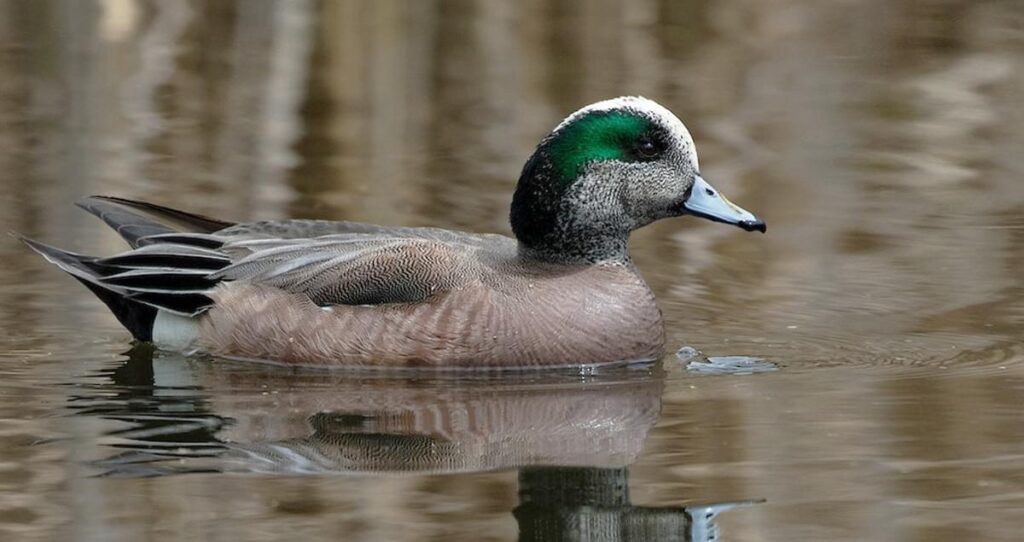
The American Wigeon has a touch of green that looks like a shiny stripe running from the eye to the back of the head. The male’s creamy white forehead and crown make him easy to recognize from afar. This round-headed duck is smaller than a Mallard but full of charm. You might hear the male’s cheerful whistling call as flocks feed in grassy wetlands or glide across lakes. The females are quieter and more modestly colored, but together, they make one of the prettiest pairs on the water.
4. Green-winged Teal
Scientific Name: Anas carolinensis
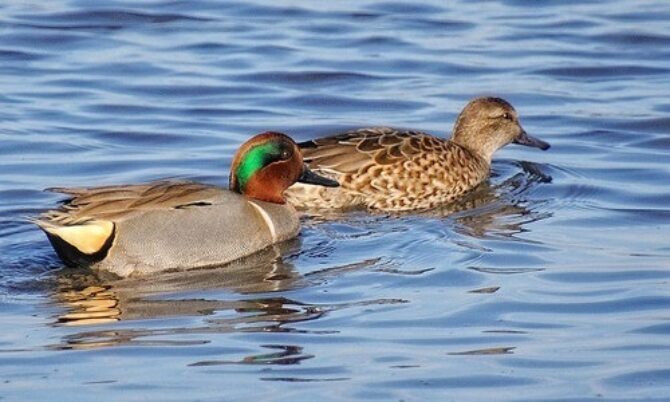
The Green-winged Teal may be small, but it’s a real gem among ducks. The male’s chestnut-colored head features a shining green stripe that sweeps from his eye all the way to the back — a flash of color that’s easy to spot even from a distance. When they fly, look for the bright green patch on their wings that gives them their name. These tiny, quick-moving ducks often travel in lively flocks, twisting and turning across the sky like dancers. They love quiet wetlands and shallow ponds, where they dabble for seeds and insects near the surface.
5. Common Goldeneye
Scientific Name: Bucephala clangula
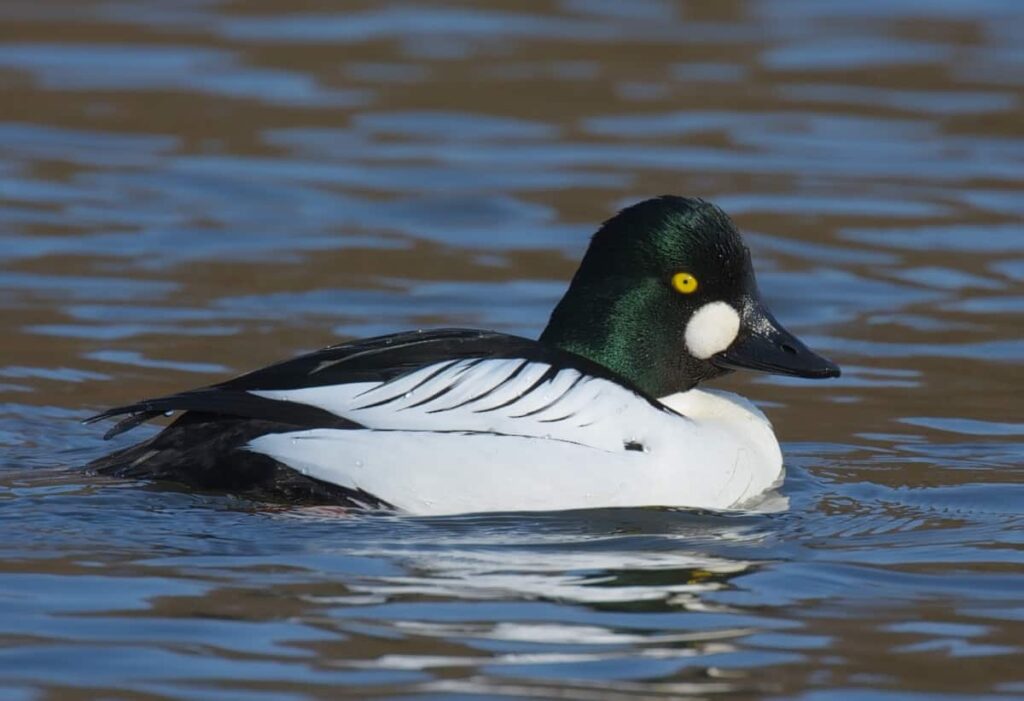
Another striking duck with a glossy green head and brilliant golden eyes is the Common Goldeneye — a true gem of northern lakes and rivers! The male’s head may look black at first, but in the right light, it glows with a dark green shimmer. He also sports a neat round white spot just below the eye — his signature mark. These ducks are expert divers, plunging underwater to catch small fish and insects. When they fly, their wings make a quick, whistling sound that’s as distinctive as their gleaming eyes.
6. Greater Scaup
Scientific Name: Aythya marila
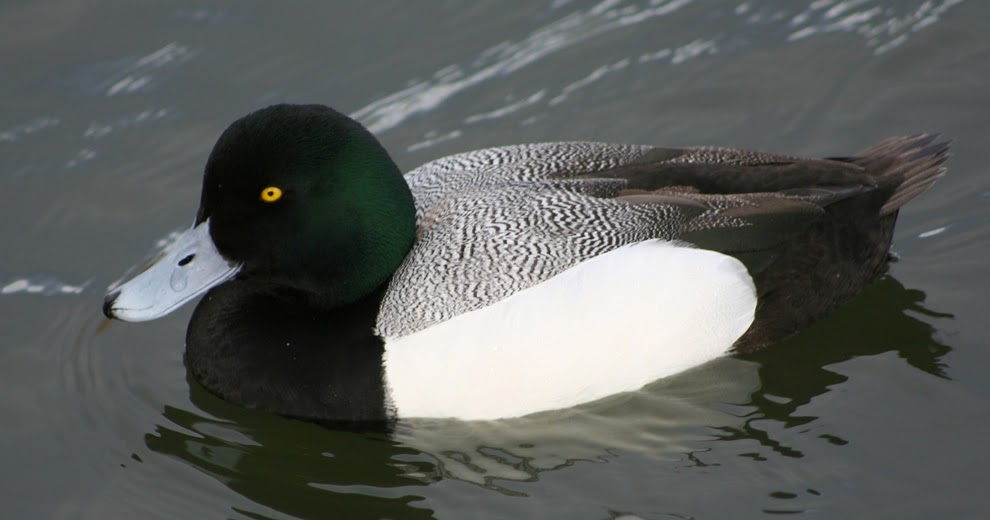
The Greater Scaup is a strong, round-headed diving duck that gleams beautifully when the sunlight hits just right. The male’s head looks black from afar, but up close it shines a glossy green that’s especially stunning during courtship. His back is pale gray and his belly white, giving him a clean, crisp look on the water. Greater Scaups prefer open lakes and coastal bays, often gathering in large, social flocks called “rafts.”
7. Lesser Scaup
Scientific Name: Aythya affinis
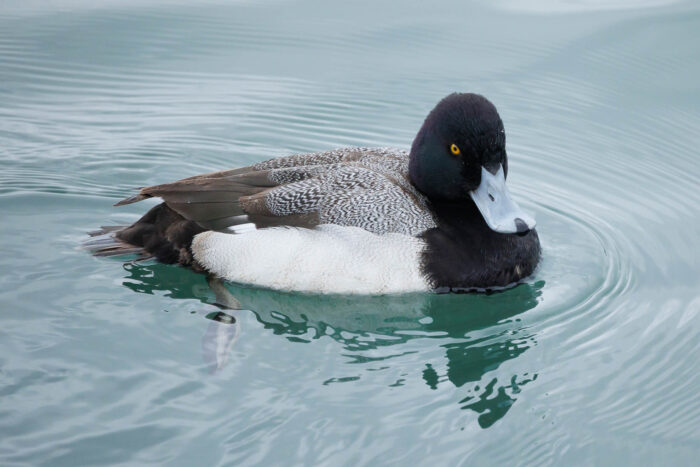
At first glance, the Lesser Scaup looks almost identical to the Greater Scaup, but look closely and you’ll see a few clues. It’s a bit smaller, with a slight peak on the back of its head. The male’s head glows with a glossy mix of green and purple tones, changing with the light — like a living jewel. Lesser Scaups are also skilled divers, spending much of their time underwater searching for snails and plants in ponds and rivers.
8. Cayuga Duck
Scientific Name: Anas platyrhynchos f. domestica
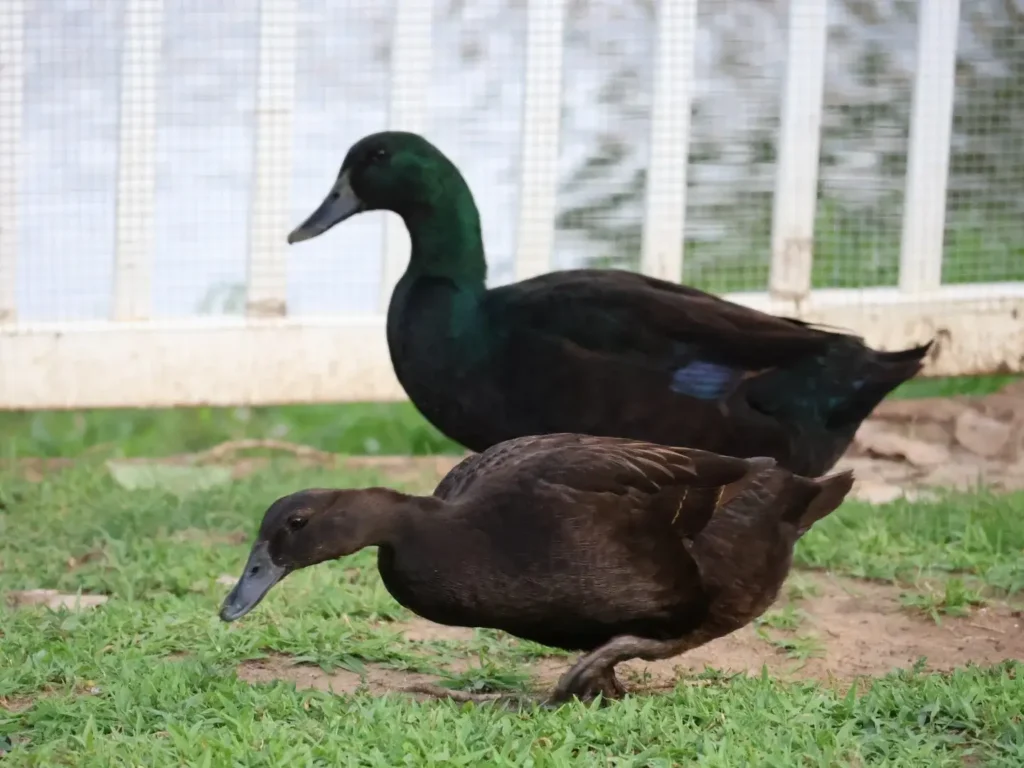
The Cayuga is a domestic duck that truly shines — literally! Its feathers are a deep, rich black with a glossy green glow, especially when the sun catches them. It’s as if the whole duck were coated in emerald light. Over time, some older birds may show a few white feathers, but the shimmering green remains their most striking feature. Calm and hardy, Cayugas are loved not just for their beauty but also for their gentle nature around farms and ponds.
9. Bufflehead
Scientific Name: Bucephala albeola
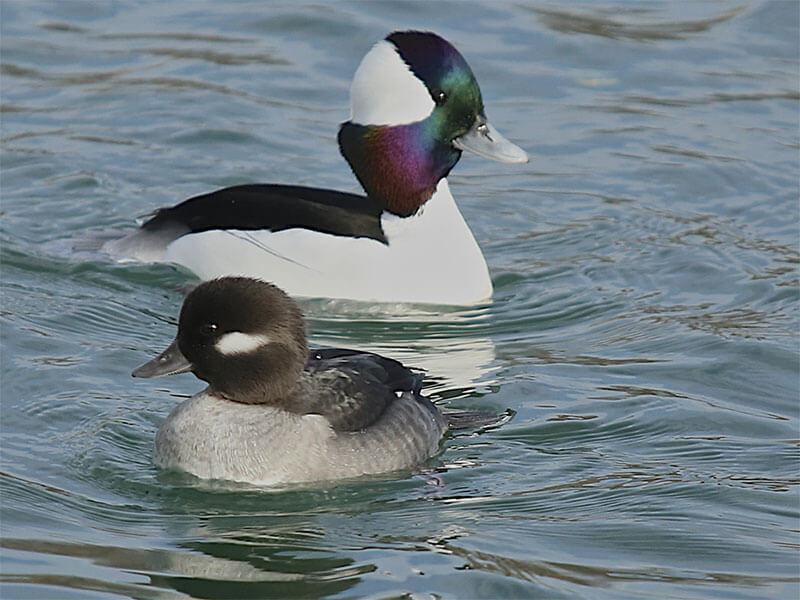
The Bufflehead is a small, compact duck with a lot of sparkle. The male’s rounded head flashes shades of green and purple, especially when sunlight hits from the side. A bold white patch on the back of his head makes him look like he’s wearing a helmet. Buffleheads are quick divers and strong fliers — always busy, always on the move. You’ll often see them bobbing on northern lakes or coastal waters, their bright colors adding life to chilly winter scenes.
10. Baikal Teal
Scientific Name: Sibirionetta formosa
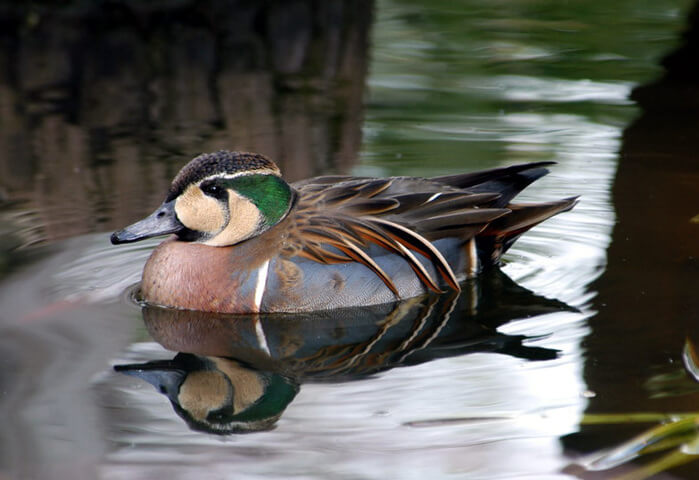
The Baikal Teal is one of the most colorful ducks you’ll ever see. The male’s chestnut head is marked with bold green, yellow, and black patterns that make him truly stand out. A green patch stretches along the back of his head and neck, shining beautifully in the light. His breast is lightly spotted, and the white bars on his sides make him look sharply dressed. The female is more softly patterned, brown with a pale face and a small white spot near the bill — elegant in her own quiet way. These ducks often gather in large flocks around lakes and marshes, especially in Asia’s cooler regions.
11. Falcated Duck
Scientific Name: Mareca falcata
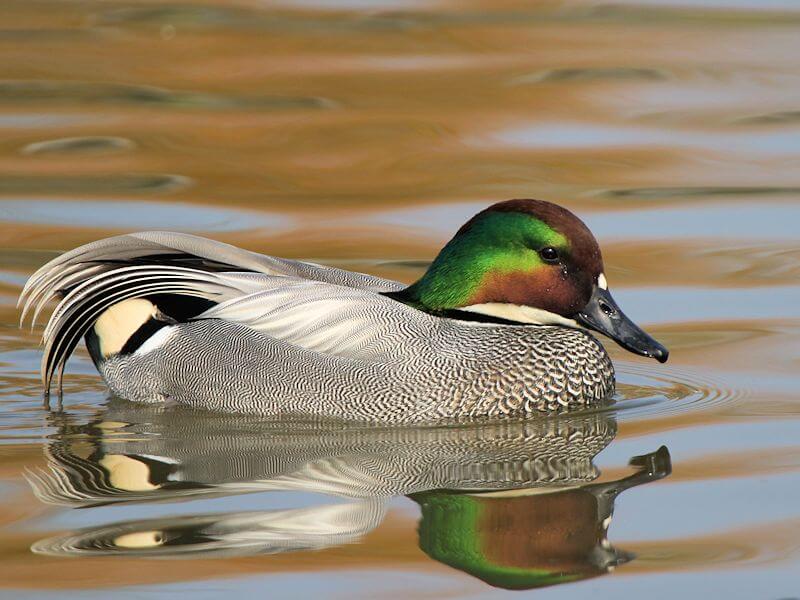
The Falcated Duck male’s head gleams with metallic green, while long, curved feathers sweep down his back like graceful blades — that’s where his name “falcated,” meaning “sickle-shaped,” comes from. His body is softly patterned with gray, white, and bronze tones, giving him a silky look. The female is more modest, dressed in shades of brown, but still easy to spot with her slender gray bill. These ducks prefer quiet wetlands and calm waters, where the males’ green heads flash in the sunlight as they glide together in pairs.
12. Common Shelduck
Scientific Name: Tadorna tadorna
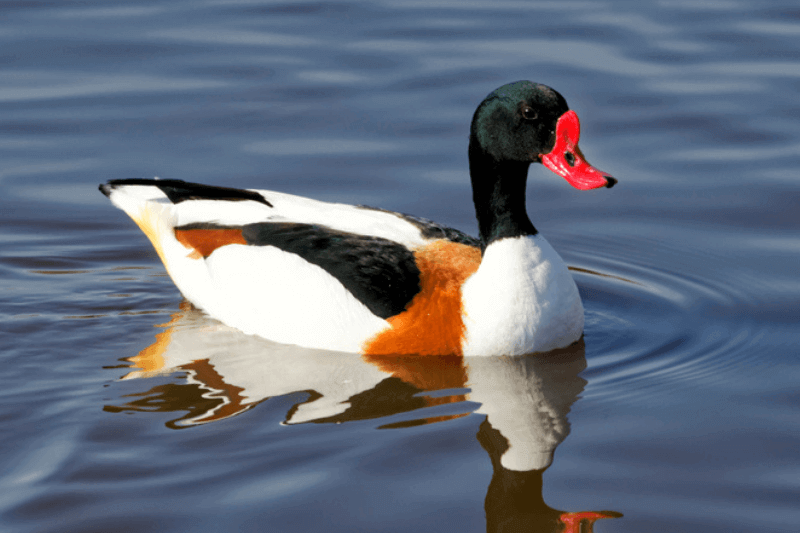
The Common Shelduck is a real showstopper! Its glossy green-black head shines beautifully above a white body and a wide chestnut band across the breast. It looks almost like a duck wearing formal clothes. You’ll often see them along coasts and estuaries, where they feed in the shallows or rest on sandy flats. Their bright red bills and smart coloring make them easy to recognize even from afar. When they fly in groups over the sea, their bold colors seem to sparkle against the blue sky.
13. Red-breasted Merganser
Scientific Name: Mergus serrator
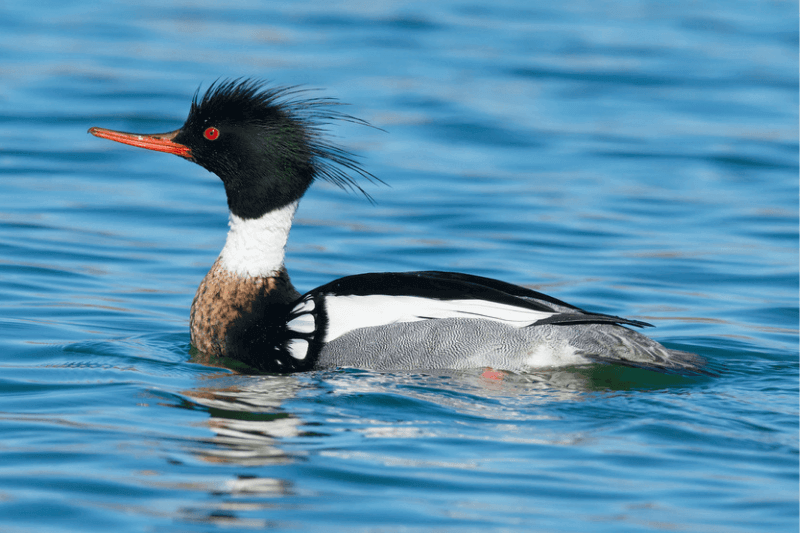
This energetic duck is easy to spot with its spiky crest and dark green head that glows like polished metal when the light hits it. The male also has a rusty chest, a long red bill, and bright white sides — a striking combination! Red-breasted Mergansers are expert fish hunters, using their narrow, serrated bills to grab slippery prey underwater. They prefer saltwater coasts and bays, diving and chasing after small fish with incredible speed.
13. Common Merganser
Scientific Name: Mergus merganser
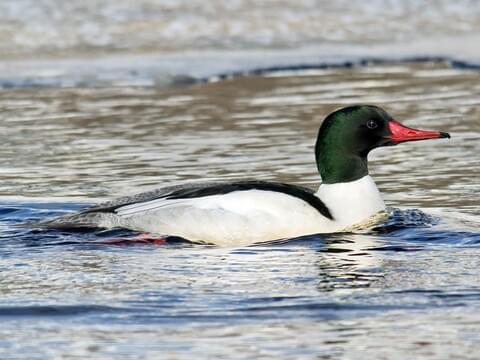
The Common Merganser is a large, elegant duck that often glides along clear rivers and mountain lakes. The male’s head may look black at first, but in sunlight it gleams with a rich green sheen — smooth and glossy. His body is mostly white with a faint pink tint, and his long red bill adds a splash of color. Females wear warm reddish-brown heads with gray bodies, looking sleek and graceful beside the males. These ducks are powerful swimmers and skilled divers, often seen fishing in cool, fast-moving waters where that green head shines as they surface.
14. Wood Duck
Scientific Name: Aix sponsa
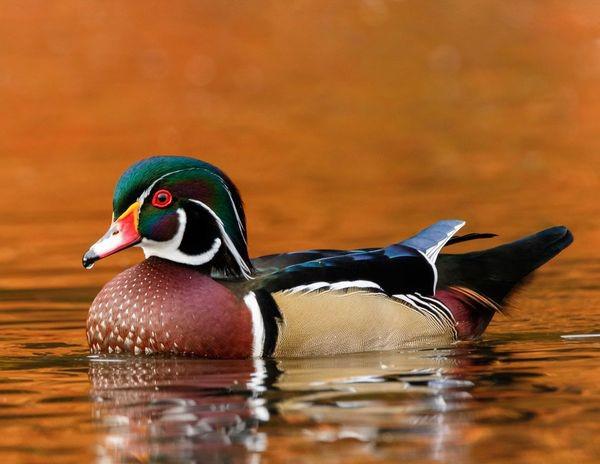
The Wood Duck is often called one of the most beautiful ducks in the world — and it’s easy to see why. The male’s glossy green and purple head shines like polished glass, with bold white stripes that make him look almost painted. His chest is deep chestnut, and his red eyes stand out vividly. These ducks like wooded ponds and quiet streams, where they nest in tree holes or nest boxes high above the water. When the light catches a Wood Duck’s green head, it’s a true “wow” moment for any birdwatcher.
15. Chestnut Teal
Scientific Name: Anas castanea
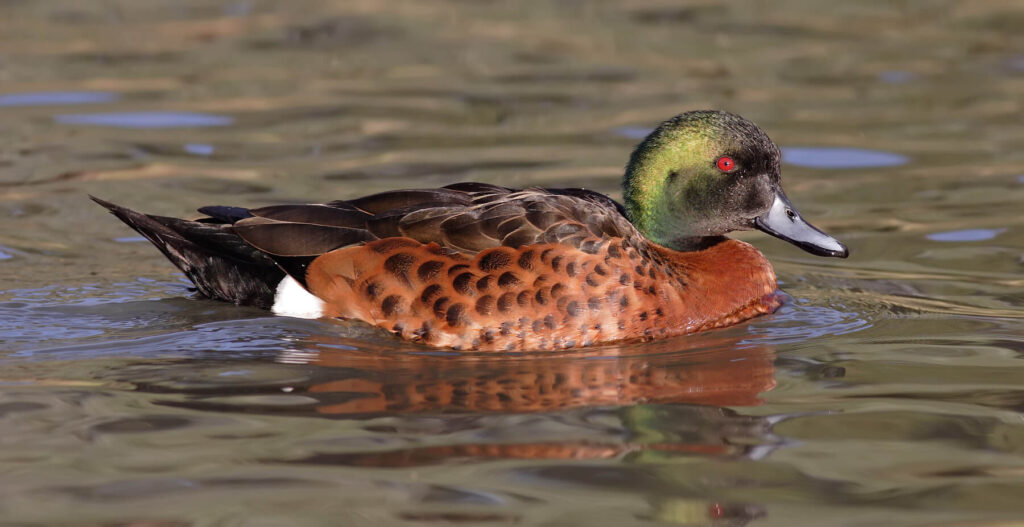
If you’re in Australia and spot a duck with a deep green head and a rich chestnut body, you’ve found the Chestnut Teal. The male’s green head glows beautifully against his reddish-brown feathers, while the female is dressed in mottled brown tones that help her blend into the wetlands. They often paddle along estuaries and marshy coastlines, calling to each other — the female’s laugh-like quack is especially easy to recognize. They’re one of the most charming ducks to watch, especially when that emerald head catches the morning sun.
16. Spectacled Eider
Scientific Name: Somateria fischeri
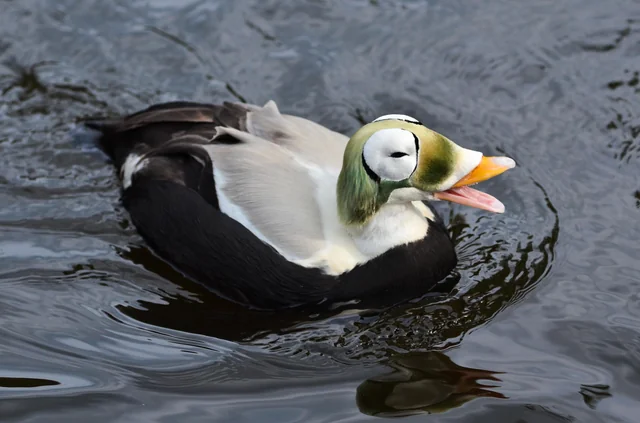
The Spectacled Eider is a true Arctic wonder. The male has a soft green head and large white circles around his eyes. His body is black and white, and his bill glows yellow-orange, giving him a striking look against icy waters. The female is warmly brown, but if you look closely, you can still see her “spectacles.” These sea ducks live in the far north, diving for shellfish and resting on the sea ice. Spotting one feels like discovering a rare treasure in a frozen world.
17. Tufted Duck
Scientific Name: Aythya fuligula
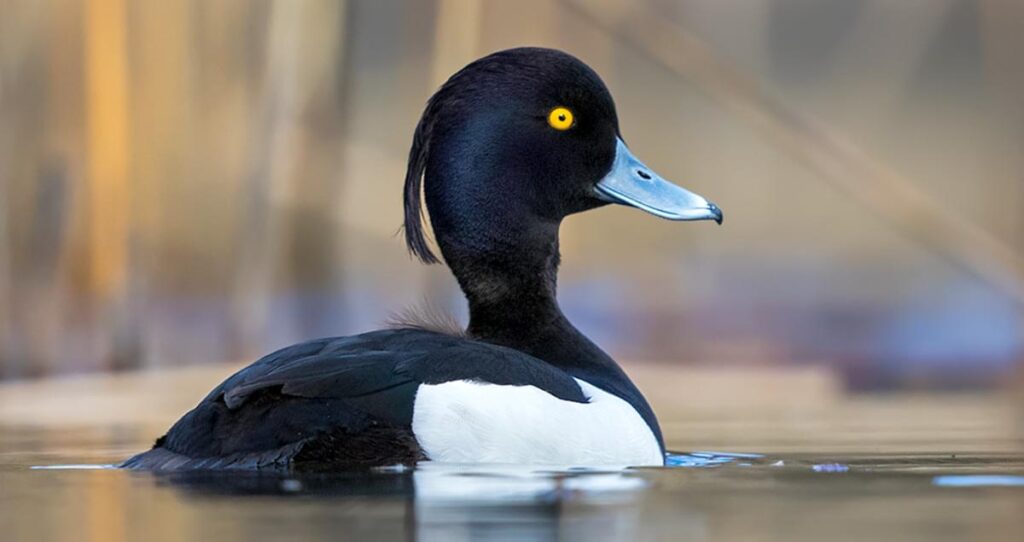
Meet the duck with the stylish hairdo — the Tufted Duck! The male’s glossy black head often shines with green or purple tints, and a neat tuft of feathers droops from the back like a ponytail. His golden eyes and crisp white sides make him easy to recognize on lakes and ponds across Europe and Asia. The female is chocolate brown with softer colors, but she still carries that little tuft that gives the species its name. They’re excellent divers and love searching underwater for snails and plants.
18. Baer’s Pochard
Scientific Name: Aythya baeri
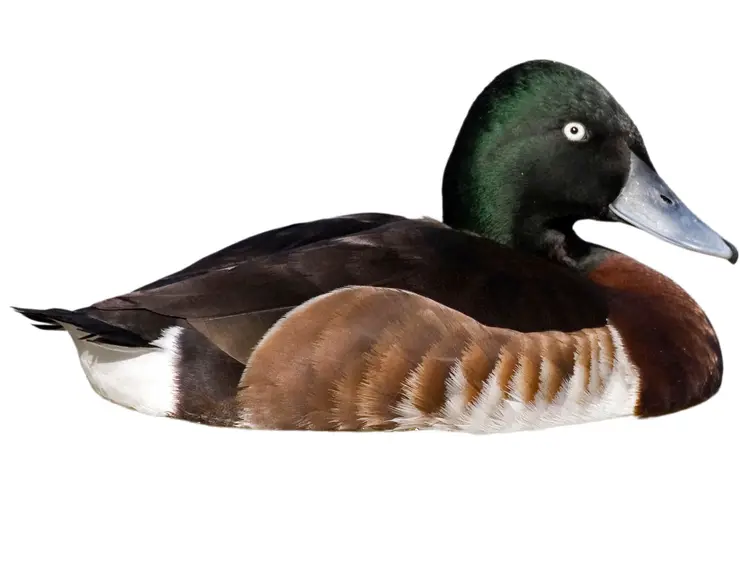
Baer’s Pochard is a rare and beautiful duck from East Asia, sadly now one of the world’s most endangered. The male’s head glows dark green, almost black in dim light, and shines like polished jade when the sun hits it. His chestnut breast and white belly add to his elegant appearance. These ducks nest in quiet wetlands, often hidden among reeds, where males stand watch while females care for the eggs. Once common, they’re now very hard to find — but for those lucky enough to see one, that green shimmer is unforgettable.
